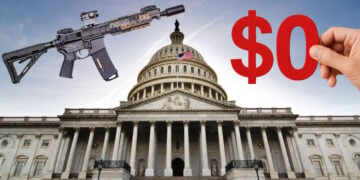Should you fire a warning shot when confronted by an attacker? In some states, it is legal to fire a warning shot, and in others, it is not. For example, California Penal Code 246.3 (negligent discharge of firearms) prohibits firing a gun in a grossly negligent manner, like a warning shot. As a felony conviction, it provides for up to 3 years in prison and a maximum of $10,000 fine. It is also a felony in New Hampshire, Tennessee, and several other states to fire a warning shot with similar penalties if you are not justified. A friend in North Carolina actually dispelled a myth of some there, saying that it is NOT a law there that you must fire a warning shot. In North Carolina, there are four elements in law for a perfect self-defense that do not include firing warning shots. After a lot of debate and strong opinions expressed by several, the Florida legislature recently passed what some call a “Warning Shot Bill,” and it is ready for the Governor to consider signing it into law now. So does the new legislation (or other Warning Shot Laws) authorize warning shots to be fired by citizens? Not really! I read the bill and could not find anyplace in it where it addresses firing a “Warning Shot.” It does amend Chapter 776, F.S. and specifies that the use of deadly force justifications contained therein apply to threatened uses of force as well as actual uses of force. It is really about the broader area of Self Defense and the use of deadly force. It allows for the threatened use of force without falling under the rule of Florida’s “10-20-Life” law, which many believe was not intended to be used in self-defense cases. What the new bill and impending law does is to make it legal in the state of Florida for one to effectively display a weapon as a threat in a self-defense situation IF proper justifications are met. I believe that self-defense is a U.S. Constitutional right. The law was changed to legally codify and specify that the threat of use of force in a self-defense situation is acceptable IF the person being attacked was in fear for his life or great bodily injury. Before passage of the new law, you can go to prison in Florida for merely placing your hand on your holstered handgun while making a verbal threat, or only pointing a gun at someone, let alone firing a shot. After it becomes law, it may be justified to threaten the use of deadly force and/or fire a warning shot, IF you were in fear of death or great bodily harm. On the surface to this non-attorney, it seems like a great addition to the law to have more flexibility to defend yourself, but the expansion of the law may provide more avenues for the prosecuting attorney to attack a valid claim of self-defense, and there are other considerations. Opponents of the changes worry they will encourage more people to fire shots and would lead to people pulling guns in unnecessary situations. Will criminals carrying guns illegally and dopers on the streets start pulling them more often? It can complicate a shooting situation by raising more questions than just providing another response in self-defense. Some try to over-simplify this issue, but situational variables, criminals, and interpretations are involved.
What about the idea of firing a warning shot? Some might say rather than shooting the attacker, you should have just fired a warning shot, but then how do you know if that would have stopped the attack? Maybe the defender should have fired five warning shots? Would that be acceptable in any encounter? Is the threat of the use of deadly force and/or the firing of a warning shot “REASONABLE?” What if the defender did not aim at the attacker or potential threat, but fired in the general direction to deter him and accidentally shot the attacker. So then is negligence or reckless endangerment involved and to what extent? What if the defender did aim at the attacker and missed because he was a poor shot and hit nearby innocents? We don’t want to get into the thousands of “what if” scenarios, but there are a lot of uncertainties, situational variables, and subjective possibilities.
Consider the question of whether you should you even threaten an attacker or fire a warning shot? Let’s consider the purpose and factors in the threat of the use of deadly force and/or firing a warning shot and the usually-recognized pre-requisites for using deadly force. GENERALLY (this varies by state and legal jurisdiction), to justify the use of deadly force in a confrontation, you must show that the attacker had the ability (weapon), immediate opportunity (close proximity) and intention (hostile words or actions) to cause death or serious bodily injury. There must be a credible threat or there is no reason to even draw or show your gun, let alone press the trigger. Some jurisdictions have other considerations, like it must be unavoidable and the last resort, must be an appropriate level relative to the threat, and/or no other option was available and reasonable, etc. Some accept that the reason for firing a warning shot is to create a credible threat of force that changes the actions of the threat. It may deter the attacker. However, a warning shot may indicate to the judge and/or jury that you were not really in a life-threatening danger. It could arise in court… If you and/or your loved ones were really in such imminent grave danger, why didn’t you shoot the bad guy? Maybe the bad guy would even say that YOU are the aggressor.
Well, it is generally accepted that if you are being attacked and are in imminent fear for your life and/or great bodily harm, then you should take decisive tactical action immediately to save your life and to stop the threat. So there are a lot of influences on your split-second response to fire a warning shot or threaten the use of deadly force. In the heat of a quick confrontation, it is very difficult to decide the appropriate level of force to employ. Using too little force could result in increased injuries or death, while using too much force could result in increased injuries or death and in legal issues. Also, if you believed in the heat of the typical 3-4 seconds “battle” that the attacker had the ability, immediate opportunity and intention to cause death or serious bodily injury to you, why did you just shoot beside him or into the air with a warning shot and not shoot to stop the threat using deadly force? If you are firing a warning shot, are you really in fear for your life? Remember, the shooter is responsible for every bullet that exits the gun and shooting it in the air or in a general direction without a target in mind is irresponsible and a risk to others. What goes up must come down, but where and on whom? The bullet will hit something or someone or both.
Do we really ever have the luxury of time to consider all these things and calmly make the best decision in a quick encounter? So, with or without any new law are warning shots ever appropriate? To me as a non-attorney layman, they are NOT and can be criminal negligence. It is my understanding that removing a handgun from a holster, or even possibly just uncovering it, can be considered a hostile criminal act in a lot of jurisdictions. I remember somewhere in my training being told: “If you are going to draw your handgun from its holster, you had better be legally justified in using it immediately.” From a tactical perspective, the decision to draw and/or fire a warning shot gives up your concealed carry advantage and conveys to the attacker that you are not prepared to shoot him at that moment. After all, what you did was to intentionally draw or present your loaded gun and deliberately miss the attacker, who was presenting an imminent threat of death or great bodily harm to you, when you fired your shot. Usually the best conflict approach is to avoid initial confrontation and introducing a gun into the situation, to not draw or present it IF POSSIBLE… no matter how difficult it may be to do so in the face of the scumbag. This is not a sign of weakness nor of your lack of power or strength, but recognition of your discipline and understanding. Anytime you introduce a gun into a confrontation, it automatically escalates it. So you only introduce a gun as a last resort, if you cannot avoid the confrontation nor resolve it by other non-lethal means. Remember, Prosecutors have terms for “warning shots”… attempted murder, attempted felonious assault, improper discharge of a weapon, brandishing, etc.
In Conclusion
Using deadly force is a deadly-serious practice and shooting someone is a life-changing event.Remember, you want to AVOID trouble if at all possible and use non-lethal means and non-excessive force first. Deadly force is an absolute last resort and whenever a gun is introduced into a situation, it naturally escalates. With that in mind and having given forethought to these above considerations (which must include ability, opportunity, and intent decisions), in a critical, dangerous moment of self-defense when you are in fear of your life, it is my opinion that you make your calm and rational decision based on that particular set of situational variables and do what you have been trained to do. Recall I am not a lawyer and cannot give legal advice. You have NOT been trained nor instructed to fire “warning shots.” You want to “Stop the Threat” and the attack and take appropriate action until the danger is gone. I sincerely do not intend nor want to “kill” anyone. If the attacker happens to die as a result of their actions, it is chance, and not the intent.
What are your thoughts about “warning shots” and the threatened use of deadly force?
Continued Success!









